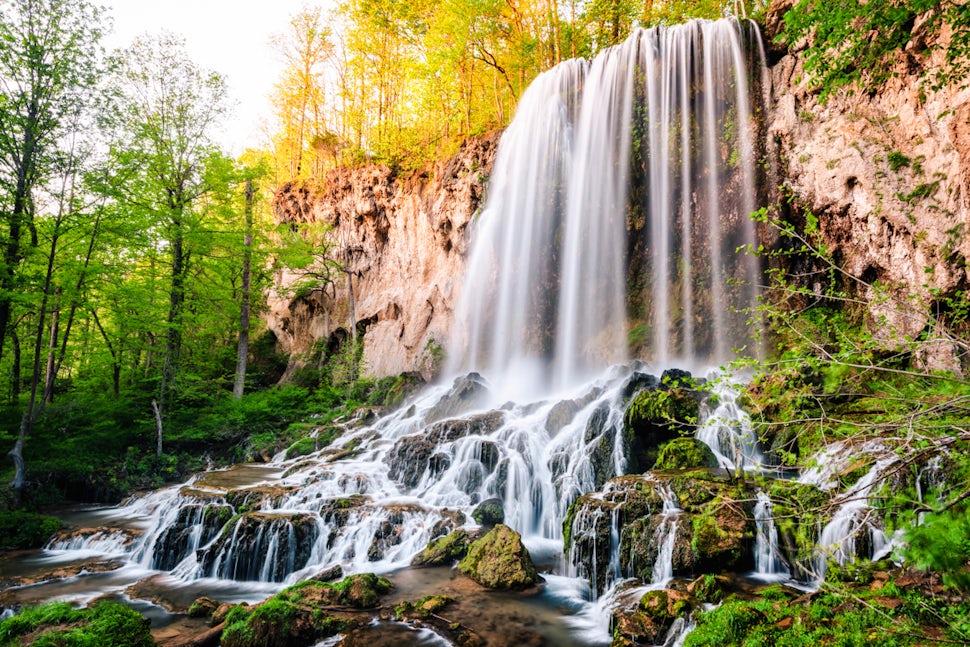7 Essential Spring Landscape Photography Tips
Essential spring photography tips which will help you take your spring images to the next level and help you make unique, one of a kind images.

1. Rain Gear
The spring rain showers and warmer weather cause nature to come back to life with wonderful wildflowers and rushing waterfalls, but this also means rain gear is vital. Having great rain gear to keep you dry and warm means you will be able to enjoy your time photographing the beautiful landscapes. Keeping your camera dry is also very important. Some higher-end cameras have weather sealing, which will help protect them from mist and light rain, but spring can cause some torrential downpours, so I suggest keeping a rain cover in your bag at all times. If you live in places like the Pacific Northwest where it is always raining, then I suggest investing in a nice well-made rain cover. For everyone else, OP/TECH makes a great, affordable option. For less than $7 USD, you receive 2 rain covers that are small, lightweight, and easy to use. I always have one in my bag, and this has helped me get some amazing images in the rain that would have ordinarily forced me to stop shooting or risk ruining my gear.
2. Boots
Mud, mud, mud…mud will be everywhere, so having a great pair of boots will make hiking to your location much easier and safer. Whether it’s to a waterfall or mountain top, photographing spring landscapes will require hiking through mud. I suggest getting a pair of Gore Tex boots to ensure your feet stay dry while slogging through mud puddles or rock-hopping across creeks or rivers.
3. Waterfalls
One of the best times to photograph waterfalls is during the spring. The added water flow from the rain and the snowmelt usually make waterfalls look their best during this season. Just be very careful because this added water also means the rivers/creeks will be moving a lot faster than normal and will easily sweep you and your camera equipment down river. According to the National Parks Service, “Water-related accidents are among the most common cause of death in some of our nation’s most visited parks,” so just be very careful when photographing these spectacular cascades. For waterfall photography tips including how to create silky smooth water click here.
4. Use Flowers in Foreground
Spring flowers help add some wonderful colors to the landscape. During the spring, wildflowers add to the beauty of the landscape by making wonderful foreground interests that can help take your image to the next level.
5. Flowers
Along with being an amazing foreground interest, the flowers themselves make great subjects to photograph. Macro lenses are great for capturing flowers, but if you do not own a macro lens, try using a long or telephoto lens. Using a large aperture F/1.4 - F/4 will help isolate your subject from the background by blurring the background. Also, don’t simply shoot down on the flower, get down low and photograph it from the level of the flower itself, or get below the flower and photograph it against the blue sky. You may have to crouch or lay on the ground to do this, but it is often well worth the effort and will provide a unique perspective in your photos.
6. Look for Fog
Cooler night temperature blowing over the wet landscape from all of the spring rain and snow melt helps form fog, which can help create some unique and dramatic landscape images. Remember when photographing fog, you will have to overexpose your image because the fog usually causes your camera’s light meter to underexpose the scene. If you are in the fog, remember to check your front element for water droplets.
7. Add Wildlife to Your Landscapes
Spring is all about new life; the trees are turning green, flowers are blooming, and newborn animals are running around with their mommas. Adding young animals to your landscape will help tell the whole story of the environment you are photographing. Most animals are usually most active in the morning or late in the evening around sunrise and sunset. Not only is this the best light to photograph landscapes but wildlife as well. Also, photographing an animal within your landscape will add scale to your image, giving your viewers some perspective of the actual size of the trees, mountains, waterfalls, meadows, etc.
We want to acknowledge and thank the past, present, and future generations of all Native Nations and Indigenous Peoples whose ancestral lands we travel, explore, and play on. Always practice Leave No Trace ethics on your adventures and follow local regulations. Please explore responsibly!
Do you love the outdoors?
Yep, us too. That's why we send you the best local adventures, stories, and expert advice, right to your inbox.














